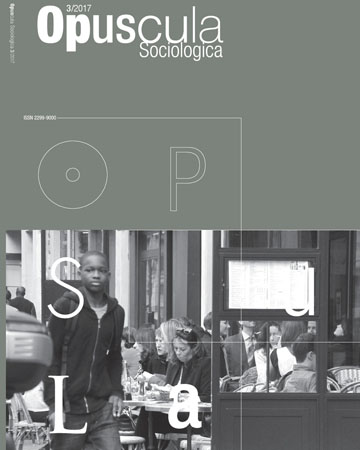
ISSN: 2299-9000
eISSN: 2353-2882
OAI
DOI: 10.18276/os.2017.3-08


Issue archive /
nr 3/2017
Chabolismo, czyli o biednym obliczu osadnictwa Cyganów i Romów w wielokulturowej Hiszpanii
(Chabolismo: Poverty Housing of the Gypsy and Romani People in Multicultural Spain)
| Authors: |
Maja
Biernacka
Uniwersytet w Białymstoku |
| Keywords: | Romani Spain close stranger distant stranger nomadism immigration |
| Data publikacji całości: | 2017 |
| Page range: | 8 (109-116) |
Abstract
This article is dedicated to the problem of poverty housing of the Gypsy and Romani people in Spain. The frst objective is to analyse the Spanish language usage with respect to the Gypsy and Romani, which is different from the Polish narration regarding these ethnicities, and to adapt them for more abstract, sociological categories of close stranger vs. distant stranger. The distinction is not only linguistic in nature: it translates into ethnic and cultural diversity, as well as to their integration in the Spanish society. The second objective is to present the specifcity of the settlements, known as chabolas, in the context of two phenomena: the Romani nomadism and immigration, whereby they become a reflection of the multicultural character of contemporary Spain. The third objective is to present the activities of the body responsible for social policy regarding those ethnicities, with a focus on the issue of housing, and to indicate the discrepancies between the aims of the policy and the particularity of their claims.
Download file
Article file
Bibliography
| 1. | Biernacka, M. (2011). Imigracyjny charakter społeczeństwa hiszpańskiego. Studia Socjologiczne, 202 (3), 161–191. |
| 2. | Corraliza, J.A., Aragonés Tapia, J.I. (1992). Satisfacción residential en ámbitos de infravivienda. Psicothema, 4 (2), 329–341. |
| 3. | FSG. (2007). Mapa sobre vivienda y comunidad gitana. Pobrano z: http://www.gitanos.org/publicaciones/mapavivienda/ (27.10.2016). |
| 4. | FSG. (2016). Programa Gitanos Inmigrantes Procedentes del Este. Fundación Secretariado Gitano. Pobrano z: https://www.gitanos.org/andalucia/programas/85375.html.es (29.10.2016). |
| 5. | Gago-Cortés, C., Novo-Corti, I. (2015). Políticas inclusivas de vivienda a través de la actuación municipal en la erradicación del chabolismo: El realojo del poblado de Culleredo (Galicia, España). Gestión y política pública, 24 (1), 131–167. |
| 6. | Gutiérrez Álvarez, E. (2011). Avilés, por una convivencia intercultural: Proceso y resultados del Plan de Erradicación del chabolismo e integración social de los gitanos en Avilés 1989–2011. Habitat y sociedad, 3, 133–150. |
| 7. | Jałowiecki, B., Łukowski, W. (red.). (2007). Gettoizacja polskiej przestrzeni miejskiej. Warszawa: Scholar. |
| 8. | Lago Ávila, M.J. (2014). El otro Madrid: el chabolismo que no cesa. Actuación autonómica en políticas de realojamiento e integración social 1997-2010. Estudios geográfcos, 75 (276), 219–260. |
| 9. | Lago Ávila, M.J. (1999). Marginalidad residential y exclusión social: El problema del Chabolismo gitano. W: J.F. Tezanos Tortajada (ed.), Tendencias en desigualdad y exclusión social: Tercer Foro sobre Tendencias Sociales (683–712). Madrid: Fundación Sistema. |
| 10. | Sugranyes, A. (2011). Chabolismo indignante: el hábitat de los que sobran. Habitat y sociedad, 3, 27–49. |
| 11. | Torres Gutiérrez, F.J. (2011). El territorio del los desheredados: Asentamientos chabolistas y experiencias recientes de erradicación en Sevilla. Habitat y sociedad, 3, 67–90. |
| 12. | Urdiales Viedma, M.E. (2003). Las cuevas-vivienda en Andalucía: de infravivienda a vivienda de futuro. Scripta Nova: Revista electrónica de geografía y ciencias sociales, 7 (146), b.n.s. |